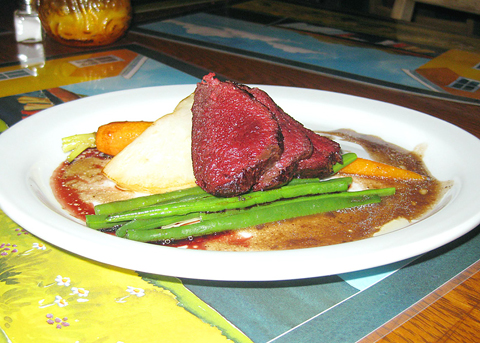Seal, hunted as food for generations in Canada’s Gulf of St Lawrence, is now drawing rave reviews from big-city chefs keen to serve it up with apples, as a pate, or even with cocoa sauce.
Fat-free and rich in iron and omega-3, seal is widely seen as a big nutritional winner.
For time immemorial seal has been eaten — raw — as a traditional food by indigenous people such as the Inuit.

PHOTO: AFP
It also has been a traditional food for generations of hunters in Canada’s east who serve it up roasted, or sometimes with a hearty Burgundy sauce.
Now, rustic seal has been carted out by back-to-basics foodies dressed up as a gourmet delight, particularly inspiring diners in mostly French-speaking Quebec Province, where there is a devoted food-lovers’ culture.
Many diners are huge fans of its taste, describing the mammal’s meat as somewhere between duck and veal.
“The texture and body of it really are unique,” said Benoit Lengnet, the French chef at Montreal’s Au Cinquieme Peche restaurant. Seal arrived on its menu two and a half years ago.
But with a super-short hunting season, from late last month to late this month, seal is a seasonal specialty that is served, rather frenetically, for just a few weeks a year.
And it comes laced with a dose of controversy as the annual seal hunt is roundly condemned by environmental groups, both in Canada and abroad. The European Parliament is due to vote in the coming weeks on a total ban favored by most EU states on importing seal-related products.
The main Canadian hunt started on April 15 off the northeast coast of Newfoundland, with an estimated total seasonal kill of 338,000 animals.
“It has been a week since we have had it [this season] and it has been half the main courses ordered,” said Lengnet, who was preparing a seal dish with truffle oil.
Luc Jomphe, head chef and owner of the Bistro du Bout du Monde restaurant, said seal “is a sort of unusual niche market product” that has really caught on.
A trailblazer in seal gastronomy, Jomphe helped start it all when he opened a restaurant five years ago on the Iles-de-la-Madeleine, in the middle of the Gulf of St Lawrence where the annual hunt kicks off.
The success still seems to be growing, Jomphe said at a tasting in Montreal.
One of his specialties is a seal “magret,” served a bit like duck magret, or duck breast, and accompanied by a cocoa-based sauce and legumes.
“It is surprising, but really good. The meat is light and does not taste like fish at all,” said a diner named Maude, acknowledging it was her first time, seal-wise.
Still, the trend has not yet become mainstream, as restaurants serving seal remain on the rather bold side.

Former Nicaraguan president Violeta Chamorro, who brought peace to Nicaragua after years of war and was the first woman elected president in the Americas, died on Saturday at the age of 95, her family said. Chamorro, who ruled the poor Central American country from 1990 to 1997, “died in peace, surrounded by the affection and love of her children,” said a statement issued by her four children. As president, Chamorro ended a civil war that had raged for much of the 1980s as US-backed rebels known as the “Contras” fought the leftist Sandinista government. That conflict made Nicaragua one of

COMPETITION: The US and Russia make up about 90 percent of the world stockpile and are adding new versions, while China’s nuclear force is steadily rising, SIPRI said Most of the world’s nuclear-armed states continued to modernize their arsenals last year, setting the stage for a new nuclear arms race, the Stockholm International Peace Research Institute (SIPRI) said yesterday. Nuclear powers including the US and Russia — which account for about 90 percent of the world’s stockpile — had spent time last year “upgrading existing weapons and adding newer versions,” researchers said. Since the end of the Cold War, old warheads have generally been dismantled quicker than new ones have been deployed, resulting in a decrease in the overall number of warheads. However, SIPRI said that the trend was likely

BOMBARDMENT: Moscow sent more than 440 drones and 32 missiles, Volodymyr Zelenskiy said, in ‘one of the most terrifying strikes’ on the capital in recent months A nighttime Russian missile and drone bombardment of Ukraine killed at least 15 people and injured 116 while they slept in their homes, local officials said yesterday, with the main barrage centering on the capital, Kyiv. Kyiv City Military Administration head Tymur Tkachenko said 14 people were killed and 99 were injured as explosions echoed across the city for hours during the night. The bombardment demolished a nine-story residential building, destroying dozens of apartments. Emergency workers were at the scene to rescue people from under the rubble. Russia flung more than 440 drones and 32 missiles at Ukraine, Ukrainian President Volodymyr Zelenskiy

Indian Prime Minister Narendra Modi is to visit Canada next week, his first since relations plummeted after the assassination of a Canadian Sikh separatist in Vancouver, triggering diplomatic expulsions and hitting trade. Analysts hope it is a step toward repairing ties that soured in 2023, after then-Canadian prime minister Justin Trudeau pointed the finger at New Delhi’s involvement in murdering Hardeep Singh Nijjar, claims India furiously denied. An invitation extended by new Canadian Prime Minister Mark Carney to Modi to attend the G7 leaders summit in Canada offers a chance to “reset” relations, former Indian diplomat Harsh Vardhan Shringla said. “This is a